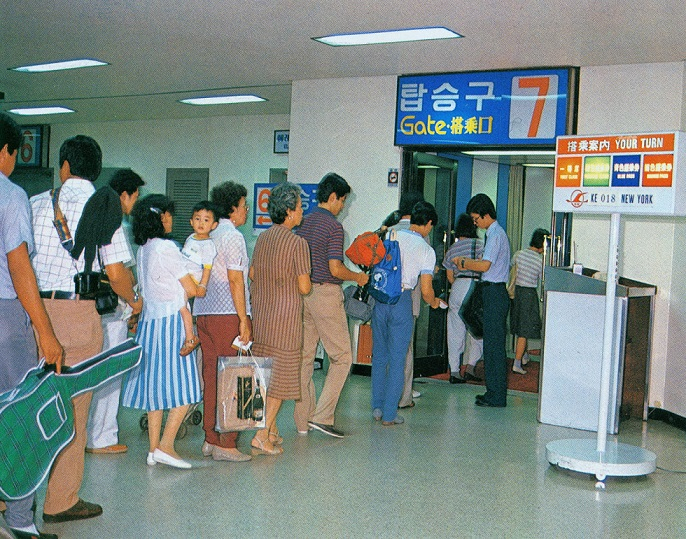 |
This undated photo from the 1990s shows passengers waiting in line at a boarding gate for a flight to New York at Gimpo International Airport. (National Archives of Korea) |
A passport was once something reserved for a privileged few in South Korea until the government began allowing all citizens to travel freely overseas on Jan. 1, 1989.
To prevent an outflow of foreign currency that would weaken the Korean currency against the dollar, as well as to minimize Koreans’ contact with communists, international travel was only permitted for certain groups of people who had special reasons for it. These included company officials or businesspeople who need to visit their foreign partners; students planning on studying abroad; and workers employed by overseas firms. Traveling abroad merely for sightseeing was completely banned.
But even those who were eligible had to meet several requirements for the visa application process, including receiving anti-communist education from conservative civic groups and passing an English proficiency test.
In 1983, the government started to lower the barrier to overseas travel by imposing an age limit on visa issuances. Koreans aged 50 and above were allowed to apply for passports or visas to travel to other countries for leisure purposes, but under the condition that they had at least 2 million won, equivalent to approximately 6.2 million won today ($4,900), in their bank account.
This was the beginning of the liberalization of overseas travel in the country.
The age cap was gradually eased to 40, then 30 in the mid-1980s, before it was completely deregulated on Jan. 1, 1989, when the government allowed everyone to travel abroad regardless of age or how much money they had in their account.
It was the wave of globalization driven by the nation’s successful hosting of the 1988 Summer Olympics in Seoul that escalated people’s yearning for outbound travel activities, according to Oh Chang-eun, professor of contemporary cultural studies at Chung-Ang University.
“Expectations for international exchanges grew sharply on the back of increased opportunities to have direct or indirect contact with foreigners during the Olympics. As people's living conditions improved amid rapid economic growth in the late 1980s, the government decided to accept people’s demands,” he explained.
The introduction of the five-day workweek in 2004 to enhance work-life balance and to help stimulate domestic consumption added fuel to outbound tourism.
Travel boom
Liberalized overseas travel regulations stimulated pent-up travel demand among Koreans, giving new momentum to the local tourism market.
An article titled “Holiday season unleashes international travel rush” on the third page of the Jan. 1, 1989, edition of The Korea Herald reported on the air travel boom ahead of the Lunar New Year holiday which fell on Feb. 6 that year.
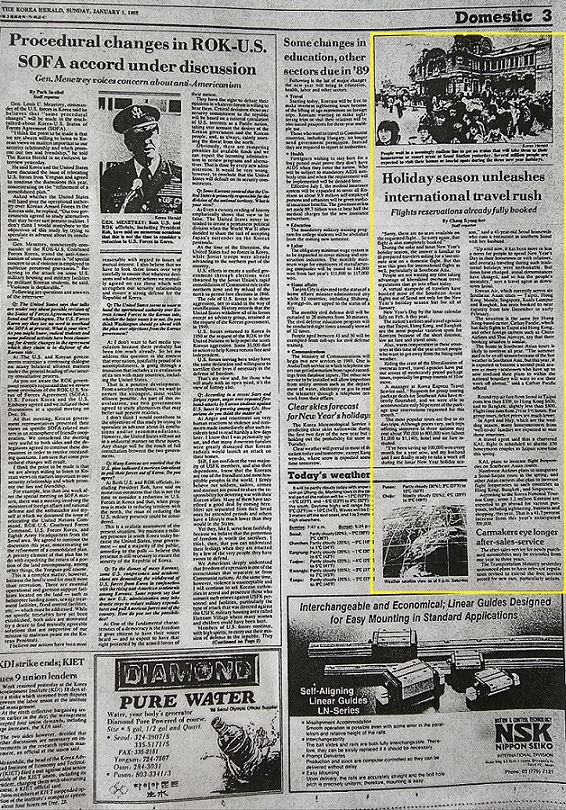 |
The Korea Herald's Jan. 1, 1989, edition (The Korea Herald) |
Flight reservations for neighboring destinations in Asia such as Taipei, Hong Kong, or Bangkok surged, and travel agencies were scrambling to attract customers by offering various package tour programs for group tourists of 10 or more.
“Requests for group touring package deals for Southeast Asia have recently flourished and we were able to accommodate only 50 percent of the package tour reservations requested for this month,” a manager of Korea Express Travel Service was quoted as saying in the story.
A package trip for five to six days, which included stopovers in three nations, was the most popular tour program. Prices varied depending on travel agencies, but they normally cost between 700,000 to 800,000 won including airfare and hotel expenses, according to the article.
“Up until now, it has been more or less a norm for people to spend New Year’s Day in their hometown or with relatives and overseas traveling during such traditional holidays was unthinkable. But times have changed, social circumstances have changed and so has the people’s mentality,” a travel agent in downtown Seoul was quoted as saying in the story.
In 1989 alone, some 1.21 million South Korean traveled overseas. This was a huge jump compared to the some 500,000 in 1985, before the travel restrictions were lifted.
Throughout the 1990s, more than 2.95 million Koreans visited foreign countries, according to data compiled by the Korea Tourism Organization.
Tourist agencies specializing in overseas trips grew exponentially, with their number rising from 254 businesses in January 1989 to 439 a year later, up 72.8 percent.
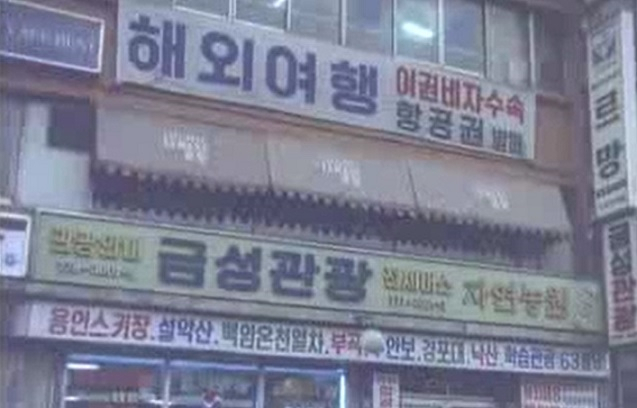 |
This footage from KTV shows signboards of travel agencies which increased in numbers after the liberalization of overseas trips in 1989. (The Korea Herald) |
With the rising popularity of overseas travel, universities started to launch study abroad programs for language learning.
While most colleges these days run student exchange programs whereby undergraduates can study abroad at foreign universities for one semester or one year, the international programs at that time were more like a group tour. Some 30-40 undergraduates used to travel as a group to English-speaking nations such as the United States, England, and Australia or Japan and go on guided bus tours in major cities.
Backpacking trips, overseas honeymoons
Backpacking became part of the university culture during the mid-1990s.
In the summer season, many went on backpacking trips, predominantly to European countries, for weeks. Young and adventurous, this new breed of travelers didn’t mind sleeping on overnight trains and subsisting on a baguette loaf for a meal, trying to explore the world as much as possible on a tight budget.
A growing number of travel agencies came up with tour programs for backpackers and the now-defunct PC communications services such as Hitel and Chollian were flooded with cyber communities where people shared travel tips.
“Back then, putting up posters around university campuses was the best advertising campaign. Many students were thirsty for new cultural experiences,” said a senior official at tour operator Naeil Travel.
Another significant target demographic for outbound tour agencies were honeymooners.
Before overseas travel for sightseeing was available to ordinary citizens, popular honeymoon destinations were Jeju Island and Gyeongju in North Gyeongsang Province.
There were even special train tour packages, such as the “honeymoon train” operated by the Korean National Railroad for newlywed couples who went on a honeymoon to these locations. On the train, honeymooners ate lunch together and socialized with each other through ice-breaker games led by a recreation instructor.
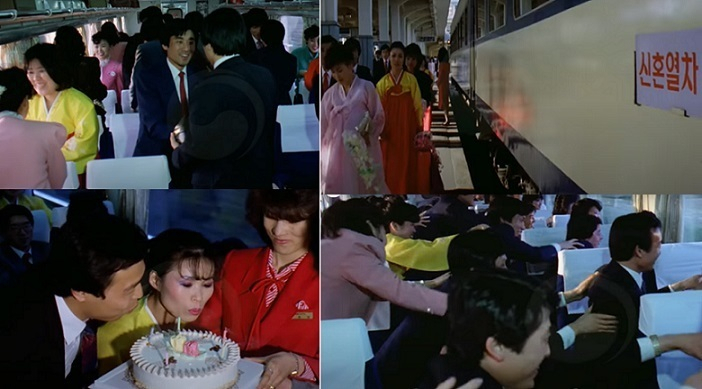 |
This footage from KTV shows the inside of a “honeymoon train,” a special train for newlyweds going on their honeymoon to destinations like the historic city of Gyeongju, North Gyeongsang Province. |
After the liberalization of overseas travel, Gimpo International Airport was crowded with newlyweds opting for exotic honeymoon locations, especially during the peak wedding season, which is between May to October.
“Friends of the groom used to gather at the airport and toss him in the air to celebrate his marriage. Popular honeymoon locations at that time were Guam, Saipan and Hawaii,” recalled a 58-year-old man living in Seoul who went to the Indonesian hot spot of Bali for his honeymoon in 1996.
Broader perspectives
Exposure to foreign cultures through overseas travel broadened people’s view of other countries as well as their own, said Oh, the Chung-Ang University professor.
When Oh went off on his very first backpacking trip to Beijing in January 1997 with a friend, he was impressed by locals who were more friendly to foreigners than he thought.
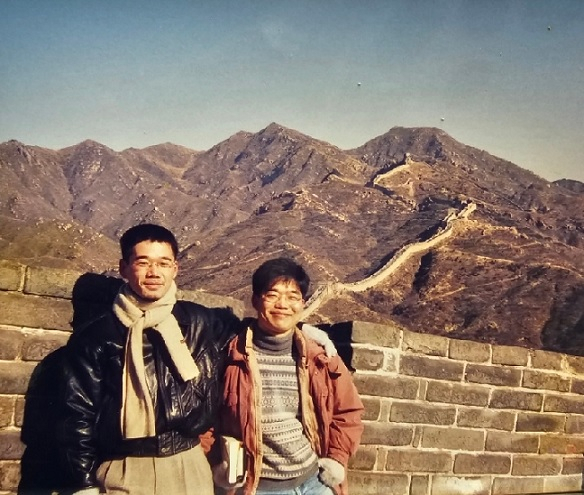 |
A picture of Oh Chang-eun, now professor of contemporary cultural studies at Chungang University, and his friend taken against the backdrop of the Great Wall of China on Jan. 19, 1997 (Courtesy of Oh) |
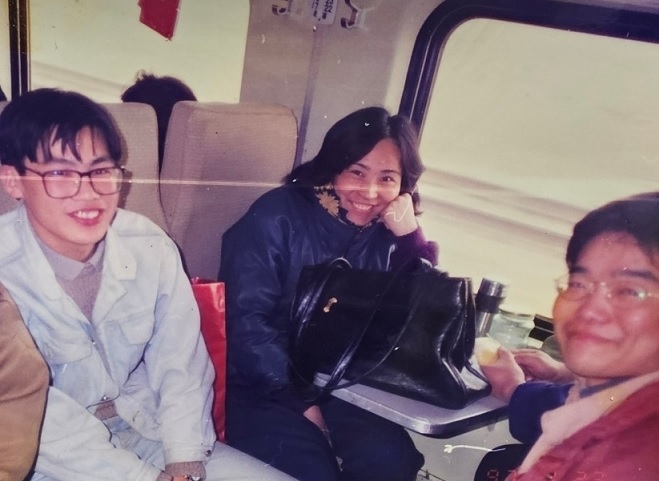 |
Oh Chang-eun (right) sits next to Chinese passengers on the train to Yan'an, in the northern part of Shaanxi province, China, on Jan. 23, 1997. (Courtesy of Oh) |
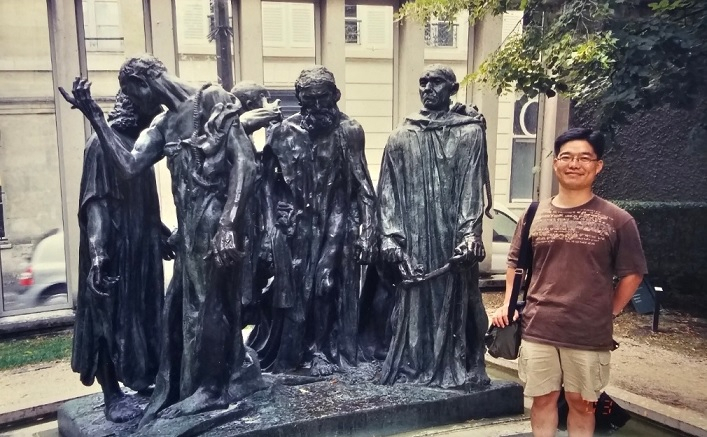 |
Oh Chang-eun stands in front of the Burghers of Calais at the Rodin Museum in Paris on Jan. 17, 2003. (Courtesy of Oh) |
“There was one time we failed to buy train tickets from Beijing to Qingdao, as the ticket office was closed. One military officer who was passing by told us about its operating hours in English. Later, one Chinese college student who was also fluent in English helped us with the ticket purchase as we struggled to communicate with staff at the ticket counter,” Oh said.
The professor noted that making contact with foreign cultures and people from different ethnic backgrounds helped ease “ethnocentric” sentiment which was then rampant among many Koreans, largely due to the previous travel restrictions.
“During my visit to Kyoto in 2001, I came to rethink how the Korean government managed and preserved the nation’s cultural assets because Japanese system and rules regarding the management of national heritage were highly advanced.
“Koreans who were continually exposed to ideas of nationalism and patriotism at schools started to develop a balanced view of their native country and the world and the idea of globalization gained more support from the public.”
The continued influx of foreign culture was another major change brought by increasing contact with the outside world, he added.
“Travel experiences led more Koreans to embrace the lifestyles of foreign cultures, diversifying people’s consumption trends or eating habits.”
Cultural exchanges at the ground level have paved the way for Korea to embrace model examples from other countries, like European schools’ educational curriculum focused on student interaction.







![[Today’s K-pop] Blackpink’s Jennie, Lisa invited to Coachella as solo acts](http://res.heraldm.com/phpwas/restmb_idxmake.php?idx=644&simg=/content/image/2024/11/21/20241121050099_0.jpg)